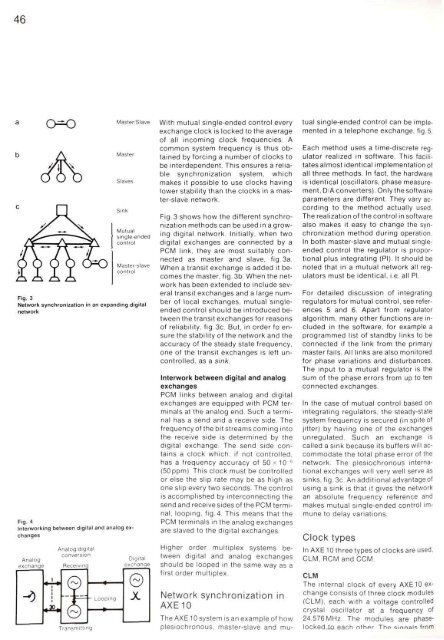TELE-X - a Satellite System for TV and Data Communication ...
TELE-X - a Satellite System for TV and Data Communication ...
TELE-X - a Satellite System for TV and Data Communication ...
You also want an ePaper? Increase the reach of your titles
YUMPU automatically turns print PDFs into web optimized ePapers that Google loves.
46<br />
Fig. 3<br />
Network synchronization in an exp<strong>and</strong>ing digital<br />
network<br />
Fig. 4<br />
Interworking between digital <strong>and</strong> analog exchanges<br />
With mutual single-ended control every<br />
exchange clock is locked to the average<br />
of all incoming clock frequencies. A<br />
common system frequency is thus obtained<br />
by <strong>for</strong>cing a number of clocks to<br />
be interdependent. This ensures a reliable<br />
synchronization system, which<br />
makes it possible to use clocks having<br />
lower stability than the clocks in a master-slave<br />
network.<br />
Fig. 3 shows how the different synchronization<br />
methods can be used in a growing<br />
digital network. Initially, when two<br />
digital exchanges are connected by a<br />
PCM link, they are most suitably connected<br />
as master <strong>and</strong> slave, fig. 3a.<br />
When a transit exchange is added it becomes<br />
the master, fig. 3b When the network<br />
has been extended to include several<br />
transit exchanges <strong>and</strong> a large number<br />
of local exchanges, mutual singleended<br />
control should be introduced between<br />
the transit exchanges <strong>for</strong> reasons<br />
of reliability, fig. 3c. But, in order fo ensure<br />
the stability of the network <strong>and</strong> the<br />
accuracy of the steady state frequency,<br />
one of the transit exchanges is left uncontrolled,<br />
as a sink.<br />
Interwork between digital <strong>and</strong> analog<br />
exchanges<br />
PCM links between analog <strong>and</strong> digital<br />
exchanges are equipped with PCM terminals<br />
at the analog end. Such a terminal<br />
has a send <strong>and</strong> a receive side. The<br />
frequency of the bit streams coming into<br />
the receive side is determined by the<br />
digital exchange. The send side contains<br />
a clock which, if not controlled,<br />
has a frequency accuracy of 50 x 10 6<br />
(50ppm). This clock must be controlled<br />
or else the slip rate may be as high as<br />
one slip every two seconds The control<br />
is accomplished by interconnecting the<br />
send <strong>and</strong> receive sides of the PCM terminal,<br />
looping, fig.4. This means that the<br />
PCM terminals in the analog exchanges<br />
are slaved to the digital exchanges.<br />
Higher order multiplex systems between<br />
digital <strong>and</strong> analog exchanges<br />
should be looped in the same way as a<br />
first order multiplex.<br />
Network synchronization in<br />
AXE 10<br />
The AXE 10 system is an example of how<br />
plesiochronous, master-slave <strong>and</strong> mutual<br />
single-ended control can be implemented<br />
in a telephone exchange, fig.5.<br />
Each method uses a time-discrete regulator<br />
realized in software. This facilitates<br />
almost identical implementation of<br />
all three methods. In fact, the hardware<br />
is identical (oscillators, phase measurement,<br />
D/A converters). Only the software<br />
parameters are different. They vary according<br />
to the method actually used.<br />
The realization of the control in software<br />
also makes it easy to change the synchronization<br />
method during operation.<br />
In both master-slave <strong>and</strong> mutual singleended<br />
control the regulator is proportional<br />
plus integrating (PI). It should be<br />
noted that in a mutual network all regulators<br />
must be identical, i.e. all PI.<br />
For detailed discussion of integrating<br />
regulators <strong>for</strong> mutual control, see references<br />
5 <strong>and</strong> 6. Apart from regulator<br />
algorithm, many other functions are included<br />
in the software, <strong>for</strong> example a<br />
programmed list of st<strong>and</strong>by links to be<br />
connected if the link from the primary<br />
master fails. All links are also monitored<br />
<strong>for</strong> phase variations <strong>and</strong> disturbances.<br />
The input to a mutual regulator is the<br />
sum of the phase errors from up to ten<br />
connected exchanges.<br />
In the case of mutual control based on<br />
integrating regulators, the steady-state<br />
system frequency is secured (in spite of<br />
jitter) by having one of the exchanges<br />
unregulated. Such an exchange is<br />
called a sink because its buffers will accommodate<br />
the total phase error of the<br />
network. The plesiochronous international<br />
exchanges will very well serve as<br />
sinks, fig. 3c. An additional advantage of<br />
using a sink is that it gives the network<br />
an absolute frequency reference <strong>and</strong><br />
makes mutual single-ended control immune<br />
to delay variations.<br />
Clock types<br />
In AXE 10 three types of clocks are used,<br />
CLM, RCM <strong>and</strong> CCM.<br />
CLM<br />
The internal clock of every AXE 10 exchange<br />
consists of three clock modules<br />
(CLM), each with a voltage controlled<br />
crystal oscillator at a frequency of<br />
24.576 MHz. The modules are phase-<br />
IOCkedJ.0 each other Thp cinnak from
















